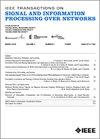Geometric Methods for Resilient Aggregation and Safe Point Computation in Adversarial Multiagent Networks With Imprecise Data
IF 3
3区 计算机科学
Q2 ENGINEERING, ELECTRICAL & ELECTRONIC
IEEE Transactions on Signal and Information Processing over Networks
Pub Date : 2025-08-05
DOI:10.1109/TSIPN.2025.3594015
引用次数: 0
Abstract
This paper studies resilient data aggregation in multiagent networks subject to both adversarial agents and imprecise state observations. We show that existing algorithms, which assume exact state information, fail under such dual uncertainty. To address this, we propose a geometric approach that models each agent’s state as an imprecision region in数据不精确的对抗多智能体网络中弹性聚合和安全点计算的几何方法
本文研究了多智能体网络中存在敌对智能体和不精确状态观测的弹性数据聚合问题。我们发现,在这种双重不确定性下,假设精确状态信息的现有算法失败了。为了解决这个问题,我们提出了一种几何方法,将每个智能体的状态建模为$\mathbb {R}^{d}$中包含真实状态的不精确区域。我们提出了不精确外壳中心点(CPIH)算法,该算法将这些区域(一些对应于对抗代理)作为输入,并计算一个保证位于正常代理真实状态凸壳内的点,尽管未知的对手身份和真实状态位置。深入分析了该算法的理论保证,并将其应用于弹性分布式向量一致性问题。此外,我们将框架扩展到动态设置,其中这些区域随着智能体靠近而缩小,在多智能体网络中推导出精确共识的充分条件,尽管只能访问不精确状态和对抗存在。数值计算验证了该方法的有效性。
本文章由计算机程序翻译,如有差异,请以英文原文为准。
求助全文
约1分钟内获得全文
求助全文
来源期刊

IEEE Transactions on Signal and Information Processing over Networks
Computer Science-Computer Networks and Communications
CiteScore
5.80
自引率
12.50%
发文量
56
期刊介绍:
The IEEE Transactions on Signal and Information Processing over Networks publishes high-quality papers that extend the classical notions of processing of signals defined over vector spaces (e.g. time and space) to processing of signals and information (data) defined over networks, potentially dynamically varying. In signal processing over networks, the topology of the network may define structural relationships in the data, or may constrain processing of the data. Topics include distributed algorithms for filtering, detection, estimation, adaptation and learning, model selection, data fusion, and diffusion or evolution of information over such networks, and applications of distributed signal processing.
 求助内容:
求助内容: 应助结果提醒方式:
应助结果提醒方式:


